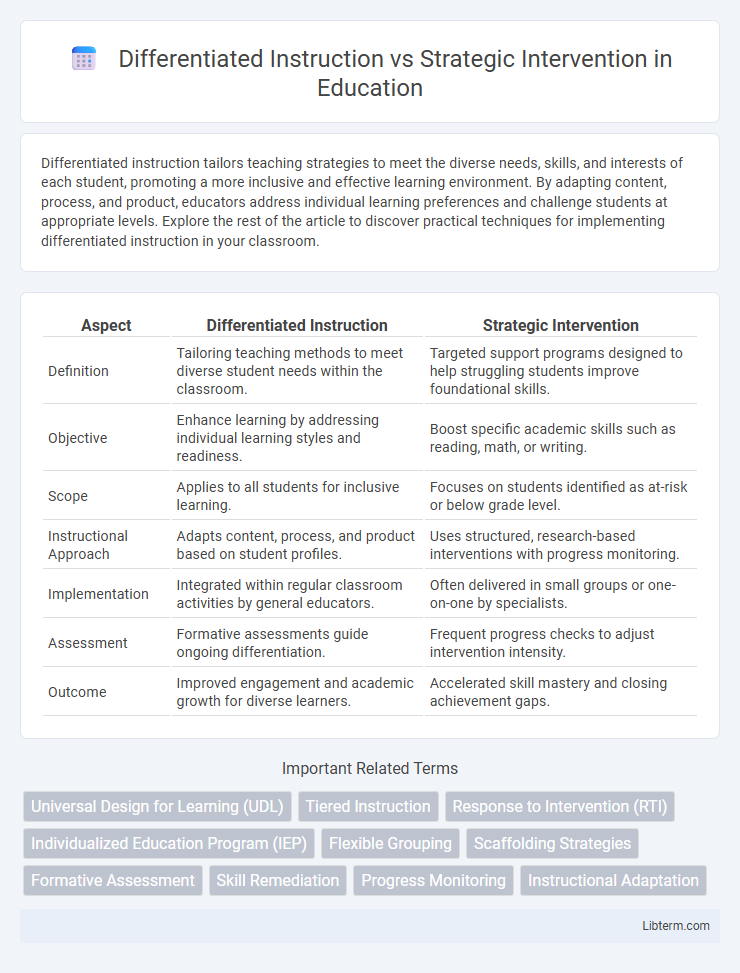Differentiated instruction tailors teaching strategies to meet the diverse needs, skills, and interests of each student, promoting a more inclusive and effective learning environment. By adapting content, process, and product, educators address individual learning preferences and challenge students at appropriate levels. Explore the rest of the article to discover practical techniques for implementing differentiated instruction in your classroom.
Table of Comparison
| Aspect | Differentiated Instruction | Strategic Intervention |
|---|---|---|
| Definition | Tailoring teaching methods to meet diverse student needs within the classroom. | Targeted support programs designed to help struggling students improve foundational skills. |
| Objective | Enhance learning by addressing individual learning styles and readiness. | Boost specific academic skills such as reading, math, or writing. |
| Scope | Applies to all students for inclusive learning. | Focuses on students identified as at-risk or below grade level. |
| Instructional Approach | Adapts content, process, and product based on student profiles. | Uses structured, research-based interventions with progress monitoring. |
| Implementation | Integrated within regular classroom activities by general educators. | Often delivered in small groups or one-on-one by specialists. |
| Assessment | Formative assessments guide ongoing differentiation. | Frequent progress checks to adjust intervention intensity. |
| Outcome | Improved engagement and academic growth for diverse learners. | Accelerated skill mastery and closing achievement gaps. |
Understanding Differentiated Instruction
Understanding Differentiated Instruction involves tailoring teaching methods and materials to address the diverse learning styles, readiness levels, and interests of students within a single classroom. This approach promotes student engagement and maximizes individual potential by providing customized learning experiences rather than a one-size-fits-all curriculum. Differentiated Instruction contrasts with Strategic Intervention, which typically targets specific skill deficits through focused support for struggling learners.
Defining Strategic Intervention
Strategic Intervention refers to targeted educational practices designed to address specific learning gaps by utilizing evidence-based strategies that enhance student comprehension and skill acquisition. It involves data-driven assessment to identify individual student needs and implement tailored support that promotes academic growth and improves performance outcomes. This approach contrasts with Differentiated Instruction, which proactively modifies content, process, or product for diverse learners within the general curriculum framework.
Key Principles of Differentiated Instruction
Differentiated Instruction centers on tailoring teaching methods to meet diverse student needs by varying content, process, and product based on learners' readiness, interests, and learning profiles. Key principles include flexible grouping, ongoing assessment, and providing multiple pathways to mastery to ensure all students engage meaningfully with the curriculum. Strategic Intervention, in contrast, targets specific skill deficits through focused support, but Differentiated Instruction emphasizes proactive, inclusive adaptation within the general classroom environment.
Core Elements of Strategic Intervention
Strategic Intervention focuses on targeted support through goal-setting, timely feedback, and skill reinforcement, addressing specific learner challenges to improve academic outcomes. It emphasizes personalized strategies such as cognitive restructuring, behavioral coaching, and emotional regulation to enhance student motivation and self-efficacy. Unlike Differentiated Instruction, which tailors content and processes for diverse learners, Strategic Intervention zeroes in on remediating precise learning gaps with data-driven, systematic approaches.
Goals and Objectives: Differentiated vs Strategic Approaches
Differentiated instruction aims to tailor teaching methods and content to meet diverse student needs, promoting personalized learning goals and fostering individual growth within the classroom. Strategic intervention focuses on targeted support for students struggling with specific skills or concepts, emphasizing measurable objectives to close learning gaps and improve academic performance. Both approaches prioritize student achievement but differ in scope, with differentiation addressing broad learner variability and strategic intervention concentrating on focused remediation.
Instructional Strategies and Techniques
Differentiated instruction employs varied teaching methods such as flexible grouping, tiered assignments, and individualized learning paths to address diverse student needs and learning styles within the same classroom. Strategic intervention focuses on targeted support strategies like explicit instruction, progress monitoring, and scaffolded lessons designed to remediate specific skill deficits or learning gaps. Both approaches use data-driven techniques but differ in scope; differentiated instruction adapts content for all learners, while strategic intervention intensifies focus on students requiring additional academic support.
Addressing Diverse Learner Needs
Differentiated instruction tailors teaching methods, content, and assessments to meet the diverse learning styles and readiness levels of all students within a classroom, promoting inclusive education. Strategic intervention focuses on targeted support for students who struggle academically, using data-driven approaches to address specific skill gaps and enhance learning outcomes. Both strategies prioritize personalized learning, but differentiated instruction proactively adapts to varied learner needs, while strategic intervention reactively provides focused remediation.
Assessment and Monitoring Progress
Differentiated instruction uses ongoing formative assessments to tailor teaching methods and materials to individual student needs, allowing real-time adjustments that enhance learning outcomes. Strategic intervention relies on frequent progress monitoring through specific assessment tools to identify skill gaps early and provide targeted support that accelerates student achievement. Both approaches emphasize data-driven decisions, but differentiated instruction integrates assessment into everyday instruction while strategic intervention often involves more structured, periodic evaluations.
Challenges and Limitations
Differentiated instruction often faces challenges such as increased teacher workload, difficulty in accurately assessing diverse student needs, and limited resources to implement personalized learning effectively. Strategic intervention encounters limitations including delayed identification of struggling students, reliance on standardized assessments, and potential stigmatization, which can affect student motivation. Both methods require ongoing professional development and systemic support to overcome these barriers and achieve optimal educational outcomes.
Choosing the Right Approach for Your Classroom
Choosing between differentiated instruction and strategic intervention depends on your classroom's unique learning needs and goals. Differentiated instruction adapts content, process, and products to cater to diverse student readiness and interests, promoting inclusive learning environments. Strategic intervention targets specific skill gaps through focused, data-driven support, ideal for students requiring intensive assistance to meet academic standards.
Differentiated Instruction Infographic

 libterm.com
libterm.com